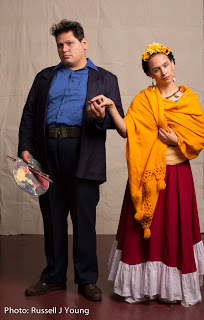 |
| Danny Moreno and Tricia Castañeda-Gonzáles portray Diego and Frida in Milagro’s revival of “Frida, un retablo” |
In January, Milagro brings back to the stage one of our most popular touring productions, “Frida, un retablo“, about the life of Mexican visual artist Frida Kahlo. Here’s an excerpt from our complimentary bilingual study guide, available online:
Frida Kahlo, daughter of Guillermo Kahlo and Matilde Calderon, was born in Mexico City in 1907. Her life was to be a long series of physical traumas, and the first of these came early. On September 17, 1925, Frida’s life changed forever. The bus she was riding in collided with a trolley car, causing a metal rod to puncture Frida’s abdomen which left her spinal column, pelvis, collarbone, right leg and foot, left shoulder and two ribs damaged. Although the incident left her almost crippled, it sparked her passion of painting self-portraits which she is well known for to this day.
During 1928, Frida met Diego Rivera again—the first encounter was during her childhood—and by August 1929 Frida and Diego Rivera tied the knot. Frida was later to say: ‘I suffered two grave accidents in my life. One in which a streetcar knocked me down… The other accident is Diego.’
While recovering from a miscarriage in Detroit, she painted Henry Ford Hospital, the first of her truly penetrating self-portraits. The style she evolved was based on Mexican folk art and in particular on the small votive pictures known as retablos, which the pious dedicated in Mexican churches.
The pair returned to Mexico in 1935, at which time Diego embarked on an affair with Frida’s sister Cristina. This incident marked a turning point in their relationship. Frida now embarked on a series of affairs with both men and women which were to continue for the rest of her life. One of Frida’s more serious early love affairs was with the Russian revolutionary leader Leon Trotsky, a communist leader who had been deported from Russia by Stalin.
Tired of Diego’s continuous affairs, in 1940 Frida divorced Diego. Additionally that same year of September, Frida decided to leave Mexico for a while to join her ex-husband in San Francisco after two assassination attempts, the latter being successful, of Trotsky. Less than two months later, while they were still in the United States, they remarried so that Diego could look after Frida, whose health had begun to deteriorate.
Due to numerous health problems, by July 1954 she made her last public appearance, when she participated in a Communist demonstration against the overthrow of the left-wing Guatemalan government. Soon afterwards, she died in her sleep. Her last diary entry read: “I hope the end is joyful – and I hope never to come back.”
